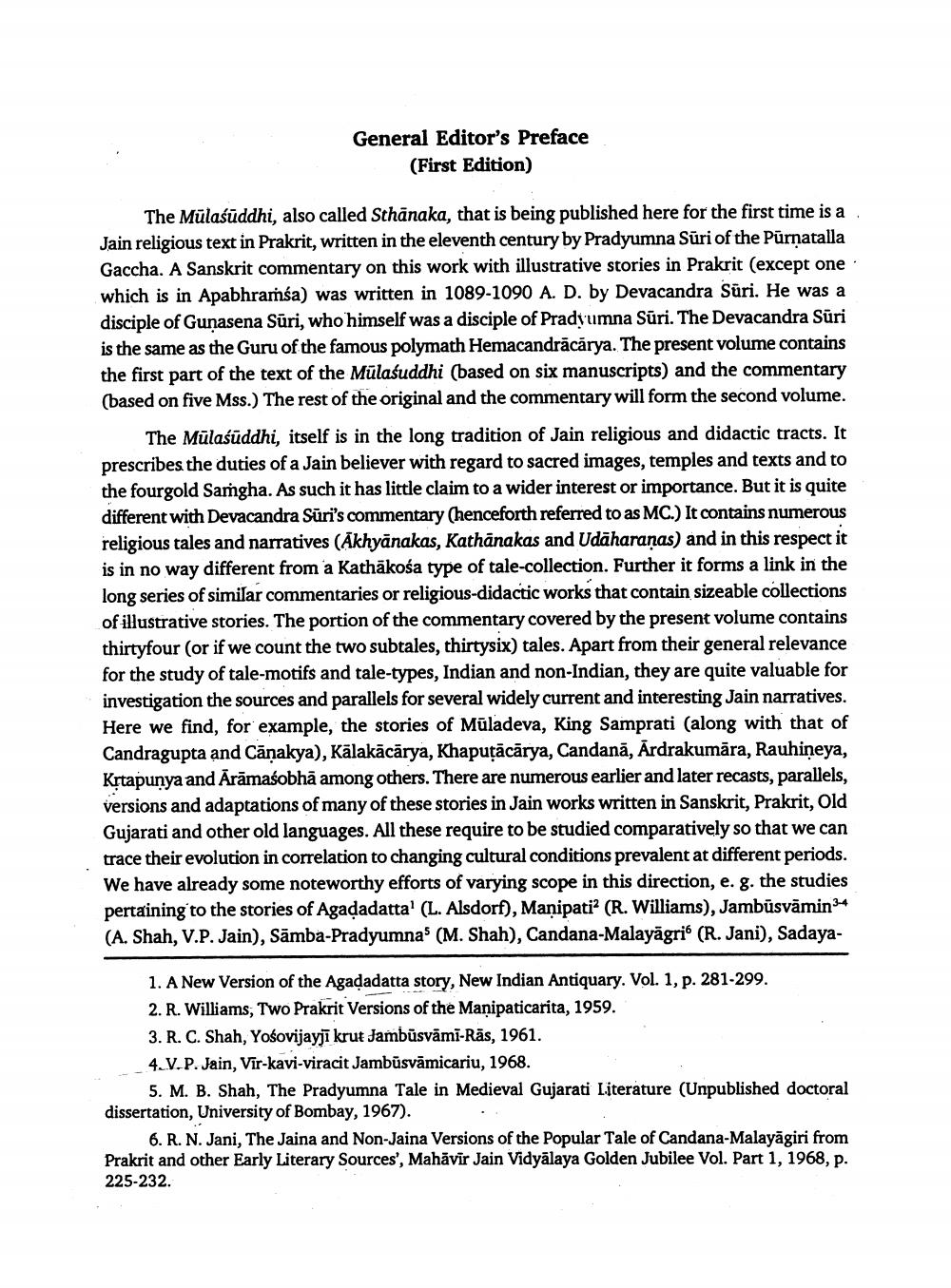________________
General Editor's Preface
(First Edition)
The Mūlaśūddhi, also called Sthānaka, that is being published here for the first time is a . Jain religious text in Prakrit, written in the eleventh century by Pradyumna Sūri of the Purņatalla Gaccha. A Sanskrit commentary on this work with illustrative stories in Prakrit (except one which is in Apabhrarśa) was written in 1089-1090 A. D. by Devacandra Sūri. He was a disciple of Gunasena Sūri, who himself was a disciple of Pradyumna Sūri. The Devacandra Sūri is the same as the Guru of the famous polymath Hemacandrācārya. The present volume contains the first part of the text of the Mülaśuddhi (based on six manuscripts) and the commentary (based on five Mss.) The rest of the original and the commentary will form the second volume.
The Mülaśūddhi, itself is in the long tradition of Jain religious and didactic tracts. It prescribes the duties of a Jain believer with regard to sacred images, temples and texts and to the fourgold Samgha. As such it has little claim to a wider interest or importance. But it is quite different with Devacandra Sūri's commentary (henceforth referred to as MC.) It contains numerous religious tales and narratives (Akhyānakas, Kathanakas and Udāharanas) and in this respect it is in no way different from a Kathākośa type of tale-collection. Further it forms a link in the long series of similar commentaries or religious-didactic works that contain sizeable collections of illustrative stories. The portion of the commentary covered by the present volume contains thirtyfour (or if we count the two subtales, thirtysix) tales. Apart from their general relevance for the study of tale-motifs and tale-types, Indian and non-Indian, they are quite valuable for investigation the sources and parallels for several widely current and interesting Jain narratives. Here we find, for example, the stories of Müladeva, King Samprati (along with that of Candragupta and Cāņakya), Kālakācārya, Khapuţācārya, Candanā, Ardrakumāra, Rauhineya, Krtapunya and Ārāmaśobhā among others. There are numerous earlier and later recasts, parallels, versions and adaptations of many of these stories in Jain works written in Sanskrit, Prakrit, Old Gujarati and other old languages. All these require to be studied comparatively so that we can trace their evolution in correlation to changing cultural conditions prevalent at different periods. We have already some noteworthy efforts of varying scope in this direction, e. g. the studies pertaining to the stories of Agadadatta' (L. Alsdorf), Manipati(R. Williams), Jambūsvāmin 34 (A. Shah, V.P. Jain), Sāmba-Pradyumna' (M. Shah), Candana-Malayāgrió (R. Jani), Sadaya
1. A New Version of the Agadadatta story, New Indian Antiquary. Vol. 1, p. 281-299. 2. R. Williams, Two Prakrit Versions of the Manipaticarita, 1959. 3. R. C. Shah, Yośovijayjī krut Jambusvāmi-Rās, 1961. 4.V.P. Jain, Vir-kavi-viracit Jambūsvāmicariu, 1968.
5. M. B. Shah, The Pradyumna Tale in Medieval Gujarati Literature (Unpublished doctoral dissertation, University of Bombay, 1967).
6. R. N. Jani, The Jaina and Non-Jaina Versions of the Popular Tale of Candana-Malayagiri from Prakrit and other Early Literary Sources', Mahavir Jain Vidyālaya Golden Jubilee Vol. Part 1, 1968, p. 225-232.




